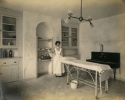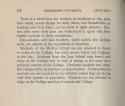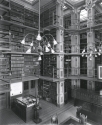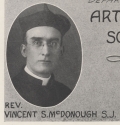In 2016, the Georgetown University Archives marks the 200th anniversary of its founding. As part of the celebration of this anniversary, a series of four exhibits will be presented online. These exhibits will look at Georgetown at 50-year intervals, starting in 1816, the year the archives was established. Drawing upon records which the Archives preserves and makes available for use, the four exhibits as a whole will trace the growth of Georgetown as a school and as a campus between 1816 and 1966.
This is the third in the series of four online exhibits. It examines aspects of Georgetown in 1916, including the appearance of campus, academic life, and recreational activities of students.
In 1916, the total student enrollment at Georgetown was around 1280 and steady. Building on the reforms of President Patrick Healy, S.J. in the 1870s and early 1880s, J. Havens Richards, S.J., President from 1888 to 1898, had expanded graduate education in the arts and sciences and built new facilities including buildings for the Law and Medical Schools, Riggs Library in Healy Hall, Dahlgren Chapel, and a hospital at 35th and N Streets. Academic offerings had expanded further with the addition of two new schools, the Dental School in 1901 and the Training School for Nursing in 1903. Georgetown now comprised six schools in all. The College and Graduate School were housed on main campus, as was the Preparatory School. The other schools were off campus - Medical and Dental on H St., Law (and after 1919 Foreign Service) at 6th and E, and Nursing at the hospital at 35th and N.
Alphonsus J. Donlon, S.J., President of Georgetown, 1912-1918. Photograph by Harris & Ewing, Washington, D.C., 1915
Father Donlon spent seventeen years at Georgetown (five as a student, six as a professor, and six as president.) During his tenure, the Georgetown Preparatory School moved from campus to Garrett Park, Maryland.
University Group. Pictured in Ye Domesday Booke, 1916
Included are images of the Preparatory School (Maguire Hall), the Law School on E Street and the Medical School (and Dental School) on H Street. The Preparatory School would move off campus to a new home in Montgomery County, Maryland, three years after this yearbook was produced and the Medical School, together with the Dental School, would move onto campus in 1930. The Medical School would be later followed by the Hospital, seen bottom right, which moved from 35th, N and Prospect Streets to Reservoir Road in 1947.
Also pictured is the "Original College" building on campus, the South Building, which was begun in 1788. Its inclusion is somewhat odd as the building was razed in 1904 to make way for Ryan Hall. As a result, it would have been unfamiliar to any student reading the yearbook.
Campus as seen from the Observatory. Pictured in Ye Domesday Booke, 1916
Seen to the right is the Aqueduct Bridge. In May 1916, a bill to replace it with a new $1,000,000 bridge was signed into law by President Woodrow Wilson. The Aqueduct Bridge was finally closed in 1923, after the completion of Key Bridge, and was demolished in 1933.
Emergency room at the Georgetown University Hospital, pictured ca. 1909
The first section of the Hospital on N Street was completed in May 1898 and opened to the public in August of that year. It included beds for 29 patients, a lecture room, and an emergency operating room. The second section opened on 35th Street in 1904, expanding the number of available beds to 100. Additional sections were added along N, 36th, 35th and Prospect Streets between 1909 and 1928. In 1947, the new University Hospital opened on Reservoir Road. The original Hospital buildings today serve as student residences (the Nevils Building, Ryder Hall, Xavier Hall, and Loyola Hall).
Healy Circle and athletic field, ca. 1920
In 1916, the main athletic field was on what is now Copley Lawn. When planning for Copley Hall and White-Gravenor began in the 1920s, the decision was made to relocate the field to the northwest of campus.
Outdoor swimming pool. Pictured in the Georgetown College Journal, October 1915
This pool, 100 feet long by thirty feet wide, was built in the summer of 1915 and located close to the present site of Harbin Hall. It was filled in by 1951.
“Georgetown Preparatory School. Proposed Building.” Pictured in the Georgetown College Journal, January 1916
In 1919, the Georgetown Preparatory School moved to a new campus in Garrett Park, Montgomery County, Maryland. The Preparatory School did not legally separate from the University, however, until 1927.
According to the Georgetown College Journal of January 1916: Though . . . situated in the country, and some nine miles from the city of Washington, the estate [the new Prep School campus] is of very easy access by reason of the fact that it faces onto the fine Rockville Pike, while the trolley line from Wisconsin Avenue, Georgetown, passes directly in the rear, and the Metropolitan branch of the Baltimore and Ohio Railroad has a station at Garrett Park, just three-quarters of a mile away, the station being reached by a good macadamized road from Rockville Pike. A trolley ride of only thirty-five minutes will carry one from the College to the proposed Prep School.
Senior Prom at the New Willard Hotel, March 6, 1916. Pictured in Ye Domesday Booke, 1916
The Prom was attended by nearly 400 couples. John Mahlum, captain of the football team, was chair of the Prom Committee and music was supplied by Meyer Davis.
Interior of Ryan Gymnasium, pictured ca. 1916
Ryan Gym, a gift of Ida M. Ryan of New York, opened in October 1906 and was designed to serve a student body of around 250. It was used as a gymnasium until the opening of McDonough Gym in 1951. Note the elevated running track around its perimeter which created shooting problems for the basketball players. A Hoya article of January 10, 1940, reports the track’s removal and notes:This structure had long been a hindrance to basketball players . . . as students know, it was impossible to make a shot from the corner of the court as the ball was blocked by the overhanging balcony.
Ryan served as a practice venue for the basketball squad for 45 years. Home games were moved there in 1914. Prior to that, home games had been played at a number of off-campus venues: Washington Light Infantry Armory (15th and Pennsylvania Avenue, N.W.); Convention Hall (5th and K Streets N.W.); Odd Fellows Hall (8th and D Streets, N.W.); and Arcade Rink (3134 14th Street, N.W.) The last home game was played in Ryan on February 21, 1931 – a 29-23 loss to the Brooklyn Knights of Columbus.
Fred Fees, L’1919. Pictured in Ye Domesday Booke, 1920
Fees played guard on the basketball team from 1916 to 1920 and was among Georgetown’s great early stars, despite standing only 5 foot 6 inches tall. The nation’s leading scorer in the 1917-1918 season, he played in 47 games and scored 804 points for a 17.1 per game average. His career total was the highest of any Georgetown player until 1948 and his career average still ranks as the third-highest overall in GU history.
Georgetown Track and Field records. Ye Domesday Booke, 1916
The first two records, for sprint events, were in 1916 still held by Arthur Francis Duffy, L’1903. Born in Boston, Duffy was one of the greatest athletes to attend Georgetown. In 1900, he held the world record for the 120 yards at 11 4/5 seconds and was the holder of all national records up to 135 yards. He became known throughout the country as the world’s fastest man.
Ticket to a Glee-Mandolin Club concert, May 12, 1916
The Georgetown College Preparatory School commencement program above tells us that music at the celebration was provided by the Georgetown College Mandolin Orchestra. Faculty lists for the College in 1915-1916 include the name of Lawrence A. Callan as Instructor in the banjo, mandolin and guitar and the 1916 Ye Domesday Book notes that: The Georgetown College Mandolin Club is beyond doubt one of the most successful clubs in the college today . . .
Admission requirements for the Law School, 1916. As printed in the 1916-1917 Catalog
A college degree was not yet required to study law. The Georgetown University Law School, exclusively a night school at this time, was one of the nation's largest. Of the total university population of 1280 students in 1916, 851 were enrolled in the Law School.
Law School Building, 6th and E Streets, N.W., ca. 1925
In 1891, the Law School moved into this, its fifth home. It remained in this location until 1971 when the Law Center opened on New Jersey Avenue. When the Foreign Service School was established in 1919, it did not have its own building and held most of its classes in the Law School building. The sharing arrangement, intended as temporary, lasted until 1932 when the Foreign Service School moved to Healy Hall.
Certificate of inspection for the steam boiler in the Law School building at 6th and E Streets, N.W., May 15, 1916
According to the Annual Report of the Commissioners of the District of Columbia for the year ended June 30 1916, the Inspector of Steam Boilers of D.C examined 525 steam boilers that year – five were condemned but not the one at the Law School.
Commencement and Alumni Reunion songbook, June 10-13, 1916
Commencement activities included an evening of singing with alumni and graduating classes in the Quadrangle. Planning documents indicate that it was thought useful to have men scattered about the audience who are familiar with these songs to lead in the singing, so all present will join therein.
Page one of the songbook includes the original words to the Alma Mater written by Robert Collier, C’1894. Note the use of the phrase, Sons of Georgetown, in the first and in the chorus. At the time the words were written, there were no Daughters of Georgetown. In 1981, after a campaign led by Carol Hession Powers, N’1941, the words were updated to their current version. The first line now reads Hail, O Georgetown, Alma Mater and the chorus ends May Georgetown live forever.
Platform at the 1916 commencement
Four hundred and twenty-nine students graduated from the College, the Medical School, the Law School and the Dental School. Former President U.S. President William Howard Taft spoke to the graduates and his comments presage the U.S.'s entry into the World War I: Coming to the present prospect of war, let us regard our position as a neutral. We have tried to be neutral but our rights as neutrals have been violated by Germany in subjecting our citizens to death without warning while traveling as they have the right to travel, on noncombatant vessels . . . Two months later, Dennis Dowd, C’1908, believed to have been the first American to travel to Europe to enlist after the outbreak of World War I, was killed in France; 10 months later the U.S. would enter the War.
Obituary for Dennis Dowd, C’1908. Brooklyn Daily Eagle, New York, August 14, 1916
Dennis Dowd of Sea Cliff, Long Island is believed to have been the first American to travel to Europe to enlist after the outbreak of World War I. He sailed for France two weeks after the War began. He was killed on August 11, 1916, flying with the famous Lafayette Escadrille, a French Air Service squadron composed largely of American volunteer pilots.
Reference to an almost three-week delay to the start of the 1916-1917 academic year. In the Georgetown College Journal, October 1916
In 1916, there was an outbreak of polio in the U.S. Infections surfaced during the summer months. As a result, public gatherings and meetings were cancelled and families were warned to avoid amusement parks and swimming pools. The death toll in New York City alone was over 2000. Nationwide, the epidemic took the lives of about 6,000 people and left thousands paralyzed.
Welcome Back Banquet menu, October 8, 1916
Traditionally, the entire undergraduate student body would celebrate the beginning of the new academic year with a banquet. In 1916, this was held on October 8. The October 1916 issue of the Georgetown College Journal described it as follows: This occasion fully measured up to those for which Georgetown is famous, and was thoroughly enjoyed by all, especially the Freshmen, who were shown for the first time a real example of Georgetown spirit. Cheers were given, first for the football team as a whole, and then for the individual members who participated in the Navy game [the first football game of the season, played on October 7]. Songs were frequent and spirit ran high.
Football Coach Al Exendine. Pictured in Ye Domesday Booke, 1916
Albert Andrew "Al" Exendine was Georgetown's football coach from 1914 to 1922. He had played college football under Pop Warner at the Carlisle Indian Industrial School where he was an All-American. After leaving Georgetown, he coached at a number of schools including Washington State University and Oklahoma State University. Exendine earned a law degree at Dickinson School of Law while coaching at Georgetown and later practiced law in Oklahoma and served with the Bureau of Indian Affairs. He was inducted into the College Football Hall of Fame as a player in 1970.
“The Georgetown College Journal," Ye Domesday Booke, 1916
The student newspaper in 1916 was a monthly publication called the Georgetown College Journal. The first printed newspaper produced by Georgetown students, it began in 1872. After The Hoya appeared in 1920, the Journal limited its coverage of campus news and turned its focus to literary and opinion pieces.
This piece gives some of the history of the publication and mentions two students on the staff of the Journal in the 1890s who went on to significant careers in publishing, Robert J. Collier, C’1894, and Conde M. Nast, C’1894. Collier became editor of the Collier’s Weekly magazine which had been founded by his father. Noted for its half-tone news pictures, Collier’s Weekly flourished under his guidance. Nast went to work as advertising manager at Collier's after graduation. In 1909, he bought Vogue, then a small New York society magazine. He later added a variety of publications to his empire, including Vanity Fair, House & Garden, and Glamour.
Riggs Memorial Library. Pictured ca. 1910
From 1891 to 1970, the University's main library was the Riggs Memorial Library, located in the south tower of Healy Hall. The Library had been financed by E. Francis Riggs of the Washington banking firm as a memorial to his late father and to his brother who had attended Georgetown.
The Library is 40 feet wide, by 60 feet long. It has a central court surrounded by three levels of balconies. Each level is divided into 12 alcoves by book stacks. The distance between the levels, slightly over seven feet, was designed to allow any book to be reached without use of a ladder.
Nursing Class. Pictured in Ye Domesday Booke, 1916
The 11th class to graduate from the Nursing School comprised Elizabeth M. Karl of Pennsylvania, Margaret R. Knott of Maryland, Carolina M. Myers of Pennsylvania, Kathryn J. Fox of Ireland, Mary A. McKenna of the District of Columbia, Lenore M. Rager of Maryland, Martha E. Rollins of Pennsylvania, Eleanor J. Prendergest of Maryland, Edith M. Conry of Maryland, Emma M. Jordan of South Carolina, and Estelle A. Potter of the District of Columbia.
Coverage of the first and second Philodemic Society debates of the 1916-1917 academic year. In the Georgetown College Journal, November 1916
The second debate was on the Adamson Act which became effective in September 1916. The act established an eight-hour work day for interstate railroad workers with additional pay for overtime work. Named for Georgia representative William C. Adamson, it was the first federal law to regulate the hours of workers in private companies. Its passage prevented a railroad strike which President Woodrow Wilson feared would impact the country’s war readiness. The United States Supreme Court upheld its constitutionality in 1917.
Description of the Seismological Observatory. As printed in 1916-1917 Catalog
The Seismological Observatory was set up in 1910 by Father Francis A. Tondorf, S.J. A number of campus sites were explored for its location, including the base of the south tower of Healy Hall. It was discovered, however, that the sway of the tower disturbed the instruments and they were transferred to a subterranean vault under the Quadrangle.
Francis A. Tondorf, S.J. Pictured in Ye Domesday Book, 1916
In addition to acting as director of Seismological Observatory, Father Tondorf served as Professor of Biology in the College and Professor of Physiology in the Medical and Dental Schools. “Tondy,” as the students called him, was something of a legend on campus. Clarence J. Schweikhardt, D’1923, noted that: Here was a man about whom no one could be neutral. So powerful was his personality that he called forth an intense reaction from all those with whom he came into contact. There were those who revered him and those who detested him, but no one ignored him. He had a brilliant and creative mind, a curiosity about all things, and a determination to improve everything and anything he could, including his students . . . He demanded the very best effort from each of his students . . . what was satisfactory work from an average student was a failure from a more gifted one. This caused bitterness among the brighter students, many of whom had never been made to apply themselves fully. Tondy failed people not because their work was bad, but because it was not good enough . . .
Tondorf Road, which runs between Prospect Street and the medical campus, is named for him.
Dental School cartoons. Ye Domesday Booke, 1916
The Washington Dental College was established in 1897 at 625 Massachusetts Avenue, N.W. In May 1901, the College was absorbed into the Medical School as its Dental Department. Both schools would share a building on H St. until 1930 when the Medical-Dental Building opened on Reservoir Road and they moved onto campus for the first time.
Tribute to Shirley W. Bowles, D.D.S., Dean of the Dental School. Ye Domesday Booke, 1916
. . . The Beau Brummel of our corridors, the genial Chesterfield of our banquet halls, the Darwin of our Clinics, and the disciplinary Napoleon of our scholastic attack . . .
Vincent S. McDonough, S.J. Director of Athletics, 1916 to 1928. Pictured ca. 1923
Father “Mac” was both revered and feared by students. In addition to serving as Director of Athletics, he was Prefect of Discipline and a student counselor. When asked what he would most like to honor his 25th anniversary as a priest, he replied: You give the boys a new gym and I’ll be happy. A few days later, on September 3, 1939, he was found dead in his room, beside a radio broadcasting news of the declarations of war by Britain and France. Lou Little, who coached under him said: I never knew a man with so broad a vision. I never knew one who understood boys as he understood them. I never saw him confronted with a decision and fail to give a fair and sympathetic answer-one that satisfied all hands and endeared him to all. McDonough Memorial Gym, which was dedicated in December 1951, is named for him.
Curated by Lynn Conway, University Archivist
























































